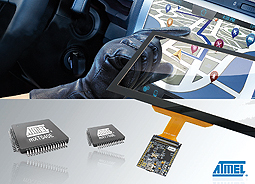
Atmel® Corporation announced the availability of its maXTouch® family for 5″ to 10″ automotive touchscreens and touchpads used in center stack displays, navigation systems, radio human-machine interfaces (HMIs) and rear-seat entertainment systems. With these new automotive-qualified devices, Atmel strengthens its position as a market-leading touch supplier and extends its range of supported maXTouch applications from consumer and industrial into automotive.
The new automotive-qualified maXTouch devices include the mXT768E and the mXT540E, which are part of a family known for its superior performance and rich feature set. This family offers unlimited touch identification, fast response time, exacting precision, robust operation and low power consumption.
Dedicated Embedded Functionality for Automotive
The mXT768E and mXT540E devices are fully automotive-qualified (Grade 2, AEC-Q100-compliant), supporting a temperature range of -40 up to +105°C.
With maXTouch automotive-qualified devices, designers can use single-layer sensors instead of dual or even triple layers, as is currently applied in many applications. Conventional touch controllers are unable to handle LCD noise, so a shield is required to prevent noise coupling. Automotive-qualified maXTouch devices provide superior noise immunity, eliminating the need for shields. This, in turn, enables single-layer sensor designs for thinner stacks, which reduces system complexity, lowers overall cost and power consumption, and results in higher product yield during automotive systems production. The high signal-to-noise ratio of 80:1 in automotive-qualified maXTouch devices makes them ideally suited for very noisy environments. Since only a high signal-to-noise ratio enables detection of touches with a “gloved” finger, the devices provide full support for gloved hand operation on automotive touchscreens.
The mXT768E/ mXT540E devices also embed single- and dual-touch gesture calculation as well as post-processing algorithms which eliminate unintended touches. Users can perform multi-touch gestures (pinch, stretch, etc.), while unintended touches such as a resting hand on the screen are classified and rejected. These functionalities bring the smartphone experience into contemporary cars.
Additional maXTouch capabilities targeting automotive applications include frequency hopping during burst generation, self calibration, detect integration addressing EMI/EMC requirements and high reliability in harsh environments. With a scan speed of up to 150Hz, design engineers can provide character recognition for alphanumeric inputs to the automotive HMI interfaces, another key feature for modern cars.
Atmel Corporation
www.atmel.com


